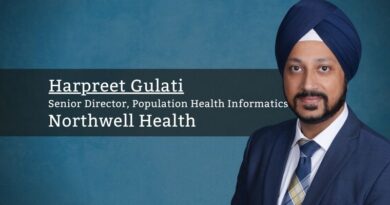The Future of Population Health in a Digital World
By Saad Chaudhry, CIO, Luminis Health
The recent pandemic years have changed many aspects of healthcare, from how it is delivered to how it is paid for and subsidized. With limitations on in-person interaction and extreme staffing shortages, many aspects of the provision of care that were previously deemed secondary or had only limited use-cases, have now entered the mainstream. Chief among these is Telehealth which has finally become a more convenient option for care provision, instead of being regarded as unique or pioneering. Similarly, Remote Patient Monitoring (RPM) is seeing expanded use beyond specialized areas of hospitals, as the technical ability to remotely ingest device readings into the patient’s record over the web has matured. RPM has especially found import in long-term care where ongoing treatment plans are based on readings provided by devices such as blood pressure cuffs, glucometers, pulse oximeters, and others.
Many envision a not-so-distant future where healthcare delivery lives, for the most part, beyond the hospital walls. And it is this future-state of a distributed model of care that will have a profound effect on population health.
By 2030, 20% of the U.S. population will be over retirement age. This means that in about seven years’ time, there will be a tsunami of demand for geriatric care, one that would easily overwhelm our population health initiatives and resources, if it were to happen today. It seems prudent, then, to build for this future today.
Some provider organizations are seeing the writing on the wall and are beginning to invest in at-home hospital programs to prepare. The idea here is to be able to provide services, whether urgent care, skilled nursing, infusion, or even hospital-level acute care, right in a patient’s home. While this approach is not new, many facets of our recent societal and digital evolution have made the environment even more fertile for it today. For example, the success of an at-home program depends heavily on the social determinants of health (SDOH) for a given population, which includes whether the recipient of care lives alone or has a support system around them each day. With remote work now a reality, this has shifted that variable drastically – it is more common now for multiple generations to be together at home, while maintaining full-time remote jobs, and supporting each other’s daily needs, from child care to meal preparation. It is, therefore, not inconceivable to imagine that in 2030, more of the older population would have full-time family support at home, while their designated care providers would come to them, to check-in periodically with supplies, meds, clinical consultations, and education. This would have positive downstream effects on healthcare providers as well, with an easing of pressure on their emergency departments and in-patient units – areas that had previously been stretched to a breaking point at most hospitals at the onset of the Covid-19 pandemic.
With telehealth now mainstream, in combination with RPM, we are seeing meaningful strides towards large-scale care management, especially when there is an established relationship and the patients are enrolled in programs with their providers.
The distributed nature of population health has long been a challenge as well; when gauging the success of a population health program, a key factor is the care-provision sites’ ability, whether they are hospitals or clinics, to provide services in a dependable manner to the communities in their immediate vicinity. With telehealth now mainstream, in combination with RPM, we are seeing meaningful strides towards large-scale care management, especially when there is an established relationship and the patients are enrolled in programs with their providers. Unfortunately, there are still many scenarios that illustrate gaps in our care models – for example, if you require urgent in-person care, do not have access to an appropriate treatment site, or if you lack an ongoing provider relationship, it is likely that your only options are to either not seek care, complicating things further, or to opt for emergency care instead. It is scenarios like this that continue to pose challenges to a comprehensive population health approach. There is a budding solution in this arena, however. One that requires many pieces of infrastructure that we now already have today, thanks largely to the transformation spurred on by the pandemic – on-demand at-home urgent care through both, in-person (also known as “mobile”) and telehealth visits.
Again, while the idea of on-demand mobile urgent care is not new, it has not yet had its time in the limelight. There do exist some firms that provide such services as an out-of-pocket expense in very limited geographies. However, most, if not all, such programs are small mobile-nursing-based companies with limited offerings and minimal diagnostic capabilities. And much like how shifts in reimbursement during the pandemic allowed Telehealth to go mainstream, to allow the disparate pieces to fall into place for this, there would need to be a focus on it by both provider and payer organizations. The “mobile” aspect of such care offers an obstacle, since it requires purpose-fitted transportation, loaded with appropriate supplies through an established supply-chain, manned by care teams that deliver on-demand location-based care, akin to rideshare platforms with delivery services.
Historically, creating an entirely new program, especially one that radically changes the mode of delivery, has been a hard thing for providers to achieve quickly at scale. Fully-integrated provider organizations with their own insurance plans and ambulatory networks do have an edge; they are able to see benefits in their communities even today, when offering at-home and/or on-demand care, even when the policy aspect and outside reimbursement have not quite caught up. This leads one to infer that it will likely be these very same organizations – which choose to invest in this realm of care provision, using the latest in digital health to extend their clinical resources – that will likely find themselves being approached by other keen health systems looking for a population health partner in the near future.



